
Catalan is a Western Romance language. It is the official language of Andorra, and an official language of three autonomous communities in eastern Spain: Catalonia, the Balearic Islands and the Valencian Community, where it is called Valencian. It has semi-official status in the Italian comune of Alghero, and it is spoken in the Pyrénées-Orientales department of France and in two further areas in eastern Spain: the eastern strip of Aragon and the Carche area in the Region of Murcia. The Catalan-speaking territories are often called the Països Catalans or "Catalan Countries".
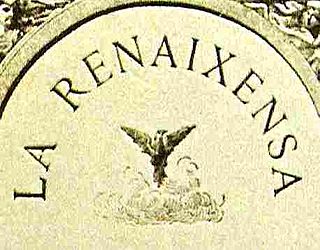
The Renaixença, or Catalan Renaissance, was a romantic revivalist movement in Catalan language and culture through the mid 19th century, akin to the Galician Rexurdimento or the Occitan Félibrige movements. The movement began in the 1830s and lasted until the 1880s, when it branched out into other cultural movements. Even though it primarily followed a romantic impulse, it incorporated stylistic and philosophical elements of other 19th century movements such as Naturalism or Symbolism. The name does not indicate a particular style, but rather the cultural circumstances in which it bloomed.
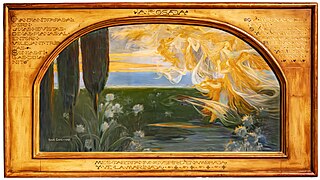
Adrià Gual i Queralt was a Catalan playwright and theatre businessman, founder of the Escola Catalana d'Art Dramàtic and a pioneer of cinema in Barcelona.

Josep Maria Benet i Jornet, also known as "Papitu", was one of the most renowned Catalan playwrights, considered one of the main renewers of Catalan theater.
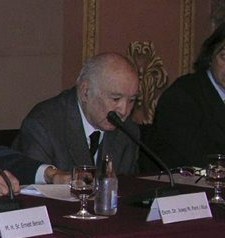
Martí de Riquer i Morera, 8th Count of Casa Dávalos was a Spanish literary historian and Romance philologist, a recognised international authority in the field. His writing career lasted from 1934 to 2004. He was also a nobleman and Grandee of Spain.
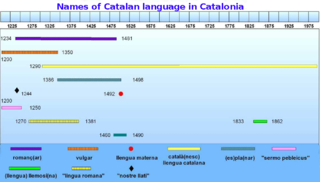
The first names, or glossonyms, of the Catalan/Valencian language formed in a dialectal relation with Latin, in which Catalan existed as a variety. These names already expressed the relationship between the two languages. New names that related Catalan to Rome came about to dignify the Catalan language in the thirteenth century, though Latinists called it vulgar and the people planus, or pla.
Antoni Rubió i Lluch was a Spanish historian and intellectual, and a Catalan patriot influenced by the Catalan Renaissance. A Hellenist and a medievalist, he left his mark on the study of the Catalan presence in fourteenth-century Greece.
Joan Abellan i Mula is a Catalan playwright and essayist.

The Catalan language originated from Vulgar Latin in the Pyrenees Mountains between France and Spain. It diverged from the other Romance languages in the 9th century. At that time, Catalan spread quickly throughout the Iberian peninsula when the Catalan counts conquered Muslim territory. By the 11th century, the Catalan language was present in several feudal documents. Catalan was present throughout the Mediterranean by the 15th century. At that time, the city of Valencia was thriving.

Caterina Albert i Paradís, better known by her pen name Víctor Català, was a Catalan writer in Catalan and Spanish who participated in the Modernisme movement and was the author of one of the signature works of the genre, Solitud (Solitude) (1905). Her literary skill was first recognized in 1898, when she received the Jocs Florals prize; soon thereafter, she began using the pseudonym Victor Català, taking it from the protagonist of a novel she never finished. Despite her success as a dramatist and her forays into poetry, she is best known for her work in narrative literature, with the force of her style and the richness of her diction being especially noted. She died in her hometown of l’Escala, Catalonia, in 1966 and is interred in the Cementiri Vell de l’Escala.

Xavier Miserachs i Ribalta was a Spanish photographer. He studied medicine at the University of Barcelona, but left school to be a photographer. He exhibited his work in Barcelona from 1956. His work is reminiscent of neorealism and is representative of the years of Spanish economic recovery, 1950–1960. His photographs show him as a creator of a new image of the city and its people. In 1998 he received the Creu de Sant Jordi of the Catalan government.

Josep Maria Nadal i Farreras is Professor of History of Language at the University of Girona.
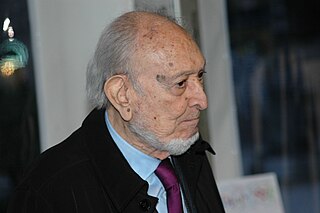
Josep Maria Castellet Díaz de Cossío, also known as José María Castellet, was a Spanish Catalan writer, poet, literacy critic, publisher and editor.
Lluís Solà i Sala is a Catalan poet, playwright and translator.

Maria Aurelia Capmany i Farnés was a Catalan novelist, playwright and essayist. She was also a prominent feminist cultural and anti-Franco activist.
La Dona Catalana was a Catalan language home and fashion magazine. It was published by Editorial Bosch in Barcelona between 1925 and 1938. Starting on 9 October 1925, the weekly periodical came out every Friday, although there was some sporadic irregularity. It was founded by a pioneer of Catalan cinema, Magi Murià. He came from a working-class family whose social status was modest, but he learned French, film and journalism on his own. His daughter, the writer Anna Murià, wrote her first article for the magazine using the pseudonym "Roser Català"; even her father did not know who was the author of that article. A total of 681 issues were published. La Dona Catalana's last issue occurred on 16 December 1938, when Franco's troops began the Catalonia Offensive.

Maria Carratalà i Van den Wouver was a Catalan concert pianist, musicologist, music critic, translator and playwright.
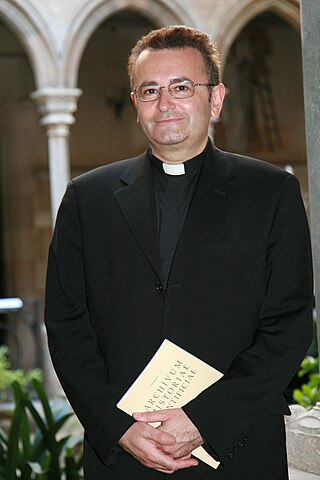
Ramon Corts i Blay is a historian priest educated at Theological Seminary of Barcelona. He was ordained in 1979 and currently belongs to the Roman Catholic Archdiocese of Barcelona.
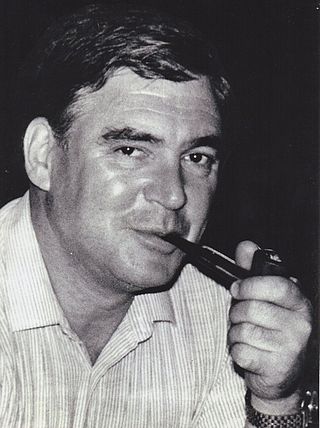
Antoni Comas i Pujol was a literary historian and literary critic, member of the Institut d'Estudis Catalans and elected member of the Acadèmia de Bones Lletres. He married Dolors Lamarca with whom he had three daughters.
Francesc Daniel Molina i Casamajó was a Spanish architect.














